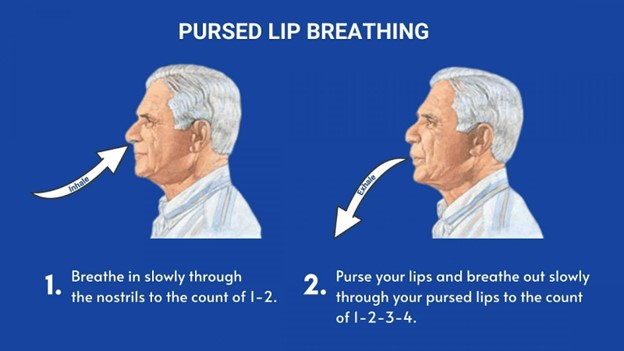A nurse is teaching pursed-lip breathing to a client who has COPD. Which of the following instructions should the nurse include in the teaching?
"Lie down while practicing pursed-lip breathing.".
"Exhale slowly through your mouth.".
"Inhale through pursed lips.".
"Puff your cheeks when exhaling.".
The Correct Answer is B
Choice A rationale:
Lying down while practicing pursed-lip breathing is not the correct instruction. Pursed-lip breathing is usually performed in a sitting or standing position. Lying down can restrict lung expansion and may not effectively support the purpose of this breathing technique, which is to improve airway pressure and reduce air trapping.
Choice B rationale:
"Exhale slowly through your mouth" is the correct instruction for pursed-lip breathing. This technique involves inhaling through the nose for a count of two and exhaling slowly and steadily through pursed lips for a count of four. The goal is to promote better exhalation, prevent airway collapse, and improve oxygen exchange. The rationale behind this choice is grounded in the mechanics of pursed-lip breathing, which helps create backpressure in the airways, maintaining them open and aiding in proper exhalation.

Choice C rationale:
Inhaling through pursed lips contradicts the proper sequence of pursed-lip breathing. The technique involves inhaling through the nose and exhaling through pursed lips. Inhaling through pursed lips would not provide the intended benefits of the technique.
Choice D rationale:
"Puff your cheeks when exhaling" is not the correct instruction. Puffing the cheeks during exhalation does not contribute to the effectiveness of pursed-lip breathing. This action could potentially impede proper exhalation and defeat the purpose of the technique, which is to control airflow and improve breathing efficiency.
Nursing Test Bank
Naxlex Comprehensive Predictor Exams
Related Questions
Correct Answer is B
Explanation
Choice A rationale:
Selecting an injection site on the abdomen 5 cm (2 in) from the umbilicus might be an appropriate instruction for some subcutaneous injections, but the specific injection site can vary based on the medication and client's needs. This choice is not a universal instruction for all subcutaneous injections.
Choice B rationale:
Expelling the air bubble from a prefilled syringe before injecting the medication is essential to ensure accurate dosing. Air bubbles can displace medication and lead to underdosing. This step is crucial for safe and effective administration.
Choice C rationale:
Aspirating prior to injecting medication is a technique used for intramuscular injections to ensure the needle is not in a blood vessel. However, for subcutaneous injections, aspirating is not necessary or recommended, as it can cause tissue damage and discomfort.
Choice D rationale:
Inserting the needle at a 15° angle is not a standard practice for subcutaneous injections. Subcutaneous injections are typically administered at a 45° or 90° angle, depending on the needle length and client's body composition. A 15° angle would not ensure proper medication delivery.
Correct Answer is B
Explanation
Choice A rationale:
Lying down while practicing pursed-lip breathing is not the correct instruction. Pursed-lip breathing is usually performed in a sitting or standing position. Lying down can restrict lung expansion and may not effectively support the purpose of this breathing technique, which is to improve airway pressure and reduce air trapping.
Choice B rationale:
"Exhale slowly through your mouth" is the correct instruction for pursed-lip breathing. This technique involves inhaling through the nose for a count of two and exhaling slowly and steadily through pursed lips for a count of four. The goal is to promote better exhalation, prevent airway collapse, and improve oxygen exchange. The rationale behind this choice is grounded in the mechanics of pursed-lip breathing, which helps create backpressure in the airways, maintaining them open and aiding in proper exhalation.

Choice C rationale:
Inhaling through pursed lips contradicts the proper sequence of pursed-lip breathing. The technique involves inhaling through the nose and exhaling through pursed lips. Inhaling through pursed lips would not provide the intended benefits of the technique.
Choice D rationale:
"Puff your cheeks when exhaling" is not the correct instruction. Puffing the cheeks during exhalation does not contribute to the effectiveness of pursed-lip breathing. This action could potentially impede proper exhalation and defeat the purpose of the technique, which is to control airflow and improve breathing efficiency.
Whether you are a student looking to ace your exams or a practicing nurse seeking to enhance your expertise , our nursing education contents will empower you with the confidence and competence to make a difference in the lives of patients and become a respected leader in the healthcare field.
Visit Naxlex, invest in your future and unlock endless possibilities with our unparalleled nursing education contents today
Report Wrong Answer on the Current Question
Do you disagree with the answer? If yes, what is your expected answer? Explain.
Kindly be descriptive with the issue you are facing.
